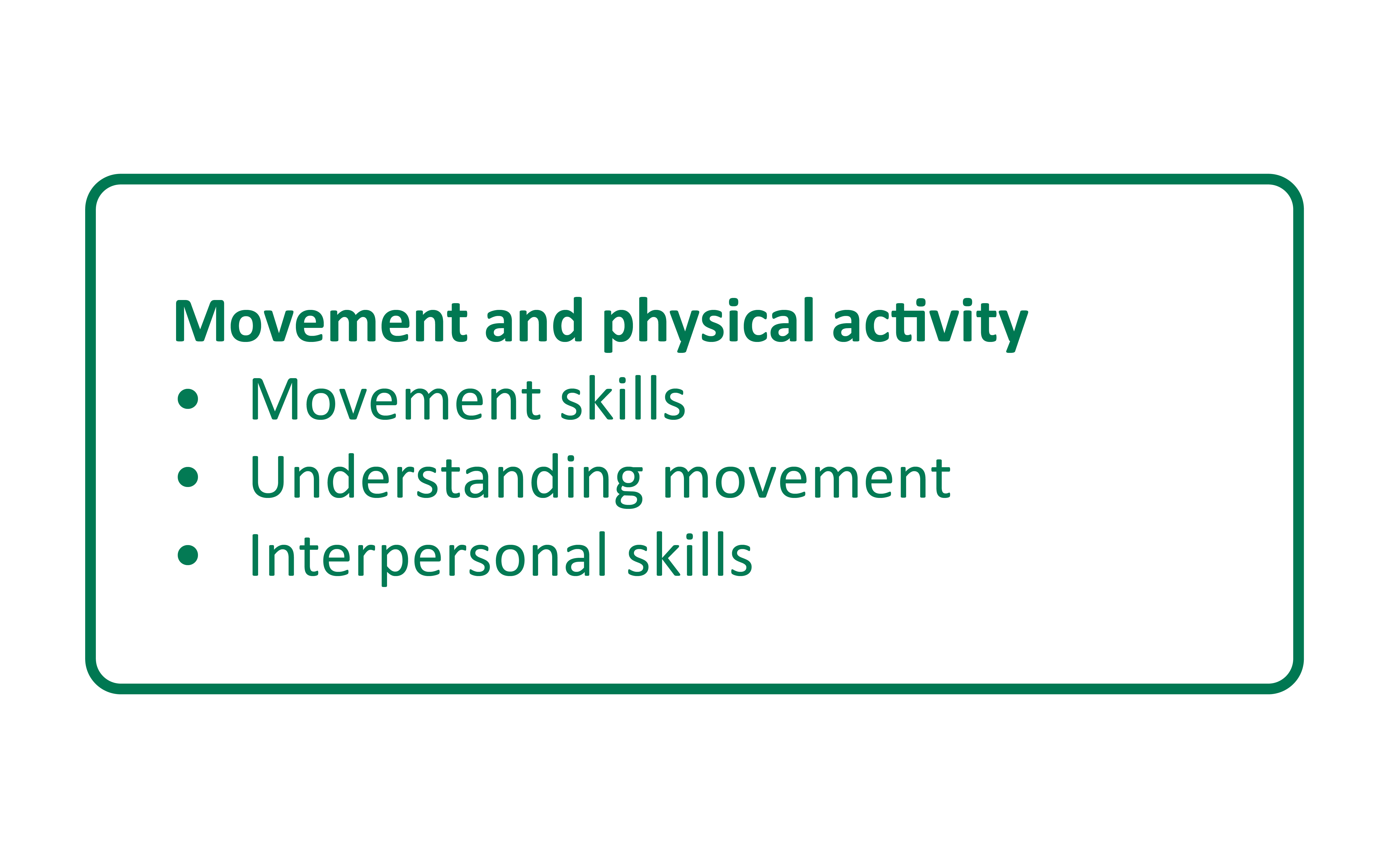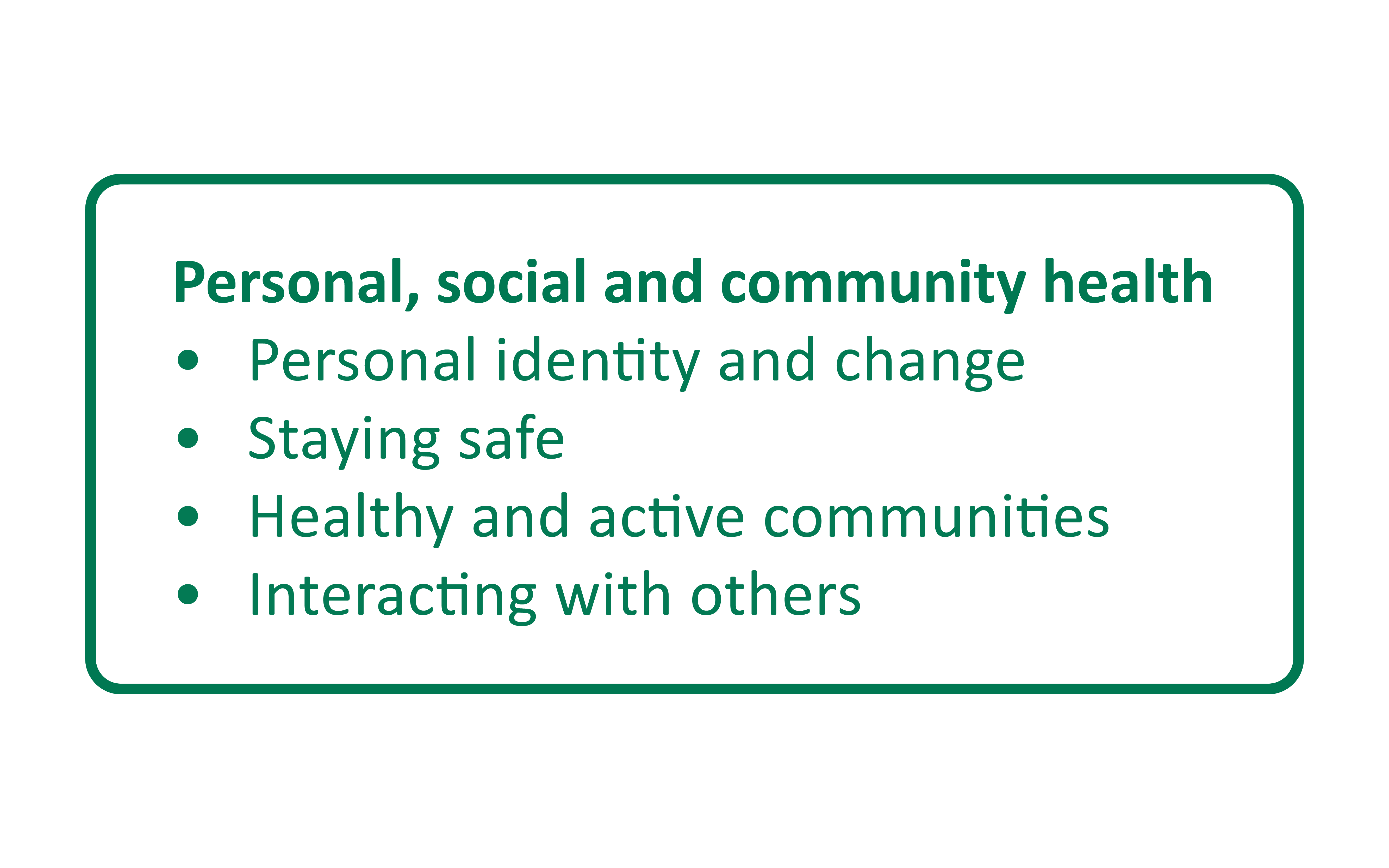Health and Physical Education - Learning Area Organisation
Learning area organisation
The Health and Physical Education curriculum is presented in year levels from Pre-primary to Year 10. The content is organised in two interrelated strands: Personal, social and community health, and Movement and physical activity. The content strands and sub-strands are illustrated below.


Health Education
The content focuses on exploring personal identities and change as individuals grow older. The content develops the knowledge, understanding and skills to support students to be resilient and to adapt to change over time.
The content focuses on supporting and empowering students to make decisions and be assertive about their safety and wellbeing.
The content develops knowledge, understanding and skills to enable students to critically analyse contextual factors that influence the health and wellbeing of communities. The content supports students to selectively access information, products, services, and environments to take action to promote the health and wellbeing of their communities.
The content develops knowledge, understanding and skills to enable students to critically engage with a range of health focus areas and issues. It also helps them apply new information to changing circumstances and environments that influence their own and others’ health, safety and wellbeing.
Physical Education
The content lays the important early foundations of play and fundamental movement skills. It focuses on the acquisition and refinement of a broad range of movement skills. Students apply movement concepts and strategies to enhance performance. They practise and rehearse skills and strategies to move with competence and confidence across a broad range of movement contexts.
The content focuses on developing knowledge and understanding about how and why the body moves, and what happens to the body when it moves. Students develop skills and dispositions necessary for enjoyable lifelong participation in physical activity, outdoor recreation, and sport.
The content focuses on personal and social skills that can be developed through participation in movement and physical activities. These skills include communication, decision-making, problem-solving, critical and creative thinking, and cooperation. The skills can be developed as students work individually and in small groups or teams to perform movement tasks or solve movement challenges. Through movement experiences, students develop other important personal and social skills such as self-awareness, self-management, persisting with challenges and striving for enhanced performance. They also experience varied roles within a range of physically active pursuits.
The interrelated nature of the content of the Health and Physical Education curriculum provides opportunities for students to develop interpersonal, communication, self-management, and decision-making skills.
Attitudes and values
The Health and Physical Education curriculum provides opportunities for students to develop positive attitudes and values about their own health and wellbeing, as well as respect for the rights and values of others. Through structured learning experiences, students examine their own attitudes and values and the level of influence they have on their own and others' health. Although attitudes and values are not specified in the syllabus content, students learn to reflect on their own and others' attitudes and values and consider how they impact on behaviour.
Focus areas
The content descriptions in Health and Physical Education must be taught through the following 12 focus areas.
addresses safe practices in relation to a range of drugs, including prescription drugs, natural and alternative medicines, energy drinks, caffeine, tobacco, alcohol, e-cigarettes and other synthetic drugs, cocaine, ecstasy, and methamphetamines.
addresses the role of food and nutrition in enhancing health and wellbeing. The content supports students to make healthy, informed food choices. Students explore the contextual factors that influence eating habits and food choices.
addresses the impact regular physical activity participation has on individual and community health and wellbeing. The content supports students to develop knowledge, understanding and skills to make active choices. They explore influences on physical activity participation and choices.
addresses how mental health and wellbeing can be enhanced and strengthened at an individual and community level. The content teaches students to maintain and enhance their own mental health and wellbeing, and to support that of others.
addresses physical, social and emotional changes that occur over time and the significant role relationships, identities and sexuality play in these changes. The content supports students to develop positive and respectful practices in relation to their reproductive and sexual health and their identities.
addresses safety issues that students may encounter in their daily lives. The content supports students to make safe decisions and behave in ways that protect their own safety and that of others.
focuses on students learning through play with people, objects and representations – indoors, outdoors, alone, with a partner or in a group. The content supports students to be physically active and develop creativity, persistence, negotiation, problem-solving, planning and cooperation.
focuses on how individuals participate in physical activities that challenge them physiologically, behaviourally and socially in diverse environments. The content supports students to assess hazards and manage risks.
focuses on the development of fundamental movement skills that support competent and confident participation in physical activities.
focuses on the development of movement skills, concepts and strategies through a variety of games and sports. This content builds on learning in active play, minor games and fundamental movement skills.
focuses on how participation in physical activity can enhance health-related fitness and wellbeing across the lifespan.
focuses on how movement can be composed and performed in response to equipment, beats and sounds, images, words and themes.
Decisions about the specific timing of individual aspects of each focus area being taught are the responsibility of schools and teachers. Planning decisions should consider local needs, available resources, students’ readiness and community priorities. Content examples provide further detail about how and when elements of the focus areas can be addressed in planning, teaching and learning.
